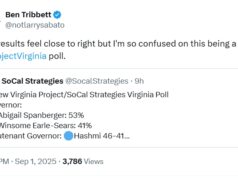 Gates’ JFCOM decision is bothersome not because of the Virginia economy; the angst about the economy is political theater. It is a narrow decision not based upon the rigor of, say, the Quadrennial Defense Review. Gates is trading competency for force structure. The cart is before the horse; a shell game.
Gates’ JFCOM decision is bothersome not because of the Virginia economy; the angst about the economy is political theater. It is a narrow decision not based upon the rigor of, say, the Quadrennial Defense Review. Gates is trading competency for force structure. The cart is before the horse; a shell game.
In the end, this is simply not the kind of decision that a bureaucrat should make. It is an expedient act for a short-term objective. And Congress should be smack in the middle of it. Meanwhile, the idea that a governor can somehow affect the process by appointing a state commission is laughable. Particularly since there is no good argument that Virginia will suffer any long term damage from the move.
“Reporting on the (2010 QDR) panel’s report, issued July 29, Perry — who served as President Bill Clinton’s defense secretary — said the military likely will need to sustain recent end-strength increases in the Army and Marine Corps for the long term as it focuses on building force structure within the Air Force and Navy”. – DoD news
The command structure of the military can certainly be streamlined. Why are there both service headquarters and redundant Department of Defense structures and functions inside the Pentagon? These constitute stove-piping and rice bowls that should be shattered. The stand-down of Joint Forces Command (JFCOM) is a bill payer for other capabilities. It was never very effective for many reasons. But it should be made effective rather than thrown out with the bath water. So far there had been no hint of this kind of move in the 2010 QDR study.
“Hadley, President George W. Bush’s national security advisor, reported the five gravest potential threats likely to arise over the next generation: radical Islamic extremism and the threat of terrorism; the rise of new global powers in Asia; the continued struggle for power in the Persian Gulf and greater Middle East; accelerating global competition for resources; and failed and failing states.” – DoD news
The greatest threats to our nation are not linear. It was part of the JFCOM mission to help develop the right capability set by simulating the environments in which we might fight and providing the analytical data to support force structure decisions. The forces being funded by eliminating training and education are a carbon copy of forces that haven’t always been effective. If they had been, we would be done in Afghanistan or at least not crying that we don’t have the right tools after all the decisions that delivered the wrong equipment.
“Hadley echoed Gates’ call for stronger “soft-power” capabilities, and recommended structural and cultural changes within the government so non-military branches can assume a larger role in protecting national interests.” – DoD news
It is JFCOM that provides the potential to integrate Gates’ “soft-power” capabilities. The military is one leg of the stool. Nowhere else has training in this aspect of the application of military power been institutionalized (except at Special Operations Command). This is training for the masses, not education for the few military leaders that can be run through the National Defense University mill. That is why JFCOM or an equivalent is a requirement. The asymmetrical battlefield is no place for the untrained.
“(Hadley) also recommended that the president and Congress establish a national commission to build the civil force for the future and provide a blueprint so civilian departments and agencies are better postured to deploy overseas and work cooperatively with military forces in insecure security environments.” – DoD news














